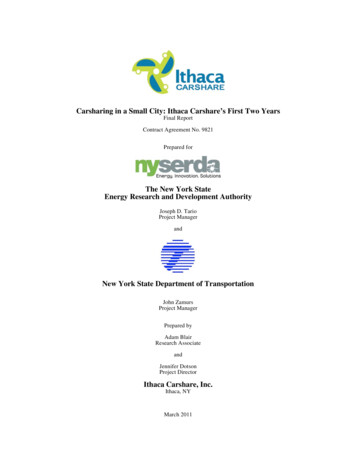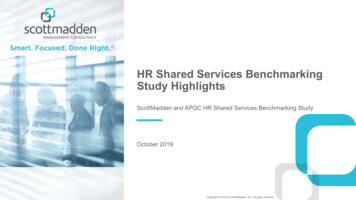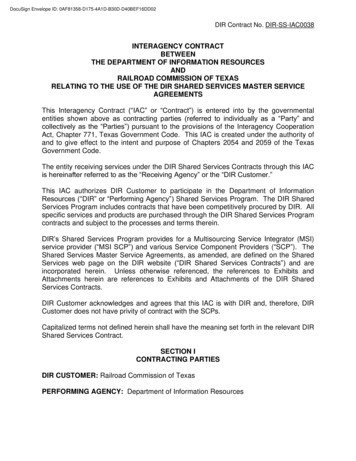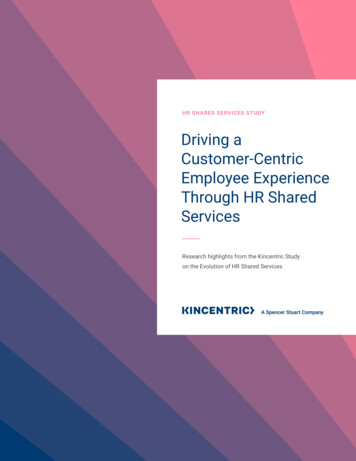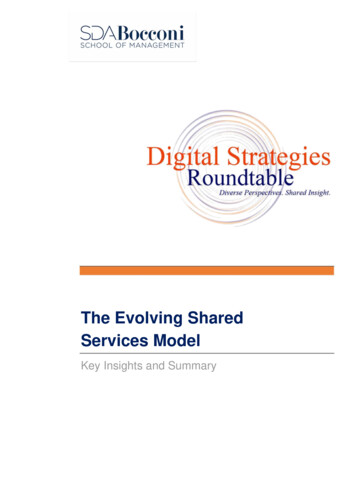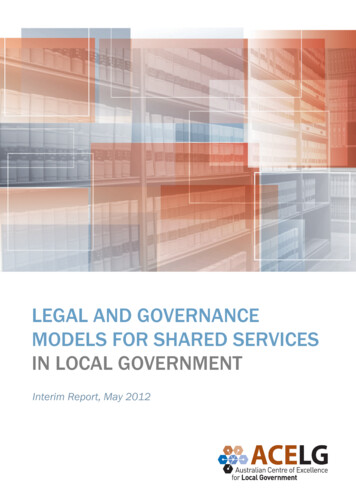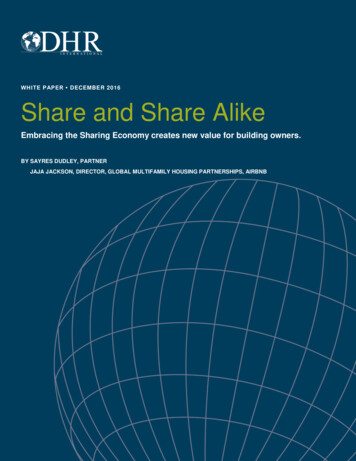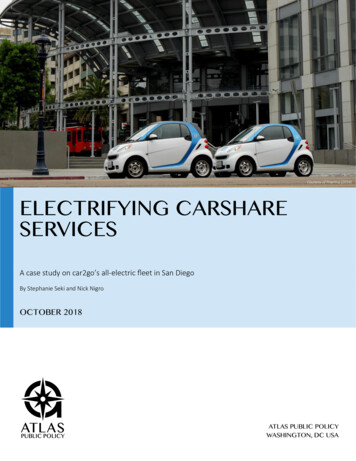
Transcription
Courtesy of Prayitno (2014)ELECTRIFYING CARSHARESERVICESA case study on car2go’s all-electric fleet in San DiegoBy Stephanie Seki and Nick NigroOCTOBER 2018ATLAS PUBLIC POLICYWASHINGTON, DC USA
ELECTRIFYING CARSHARE SERVICESA robust charging network and policies supportive of electric vehicles (EVs) are critical to improving thebusiness case for free-floating carshare services. In electrifying these services, the potential exists toreduce greenhouse gas emissions from the light-duty vehicle sector. Free-floating carshare services haveespecially difficult operational models for EVs as they can be picked-up and dropped-off anywherewithin a large service area. The experience of car2go with their all-electric carshare fleet in San Diego atthe early stage of the EV market demonstrates the challenges of transportation electrification. The shortrange of the company’s smart fortwo EVs and the lack of available charging infrastructure, due to thefailure of the partner charging company, led to major issues keeping the EVs charged and in-service. Inaddition, unfamiliarity with the EVs resulted in customer confusion, and overall lack of trust in theservices. Although car2go was unable to sustain their electric fleet in the United States, they continue tooperate in a few European cities with EV-friendly policies.Currently, EVs are offered in other free-floating carshare programs, but many of the same chargingchallenges persist. However, charging availability is significantly better now than when car2go launchedin San Diego in 2011. Electrification of shared mobility services is an emerging interest area, which hashelped to bring more attention to the deployment challenges and the role of policies and regulationsthat could help establish sustainable business practices. With more companies in the market and newpilot programs underway, the shared mobility community can continue to grow and learn from theseexperiences.This case study on car2go is a part of “Making the Business Case for Smart, Shared, and SustainableMobility,” a project which aims to accelerate the adoption of electric vehicles in shared mobility servicesand to establish best practices that can be used by other public agencies around the United States.INTRODUCTIONFIGURE 1: EV SHARED MOBILITY PROJECTATLAS PUBLIC POLICYFour U.S. cities have joined together todemonstrate the potential for electric sharedmobility services. “Making the Business Casefor Smart, Shared, and Sustainable MobilityServices” (EV Shared Mobility) aims toaccelerate the adoption of electric vehicles(EVs) in shared mobility applications and toestablish best practices that can be used byother municipal and regional governments andbusinesses around the United States. Theproject, led by the City of Seattle and AtlasPublic Policy, brings together the U.S.Department of Energy’s Energy EfficientMobility Systems program and major industrystakeholders with the cities of New York,Denver, and partners in Portland to test2
ELECTRIFYING CARSHARE SERVICESdifferent interventions designed to increase the adoption of EVs in shared mobility services. Visitwww.evsharedmobility.org to learn more about the project.Each project partner in the four cities will test a market intervention and analyze its impact on EVadoption and electric vehicle miles traveled for carshare and/or ride-hail services. A major part of theproject is to share the results, successes, and lessons learned through these pilot programs. The projectpartners will not only facilitate the implementation of EVs and EV charging for the programs, but they willalso evaluate the policies and programs that were employed during the project period.To inform the program development, the project team has prepared case studies to assess previous andongoing efforts to electrify shared mobility services. This case study focuses on car2go’s electrification ofcarshare services. A second case study looked at electrifying ride-hail services.BACKGROUNDThe transportation sector generated 27 percent of greenhouse gas (GHG) emissions in the United Statesin 2015 of which, the light-duty vehicle sector was responsible for 60 percent of the emissions [1].Electrification of light-duty vehicles can reduce GHG emissions as driving a battery electric vehicle resultsin fewer lifecycle GHG emissions than driving a gasoline vehicle with a fuel economy of 80 miles per gallon(on average across the United States) [2].With shared mobility growing in popularity [3, 4, 5], electrification of these services can help cities andstates reduce their GHG emissions attributed to light-duty vehicles. Within the shared mobility space,carshare services are a promising area to focus on for electrification efforts. Carshare companies provideusers access to a car for short-term rental periods without the costs and responsibility of owning apersonal vehicle. Carshare companies maintain a variety of business models and some offer multipleservices. This case study focuses on the carshare company car2go and their free-floating carshare service,which allows users to pick-up and drop-off vehicles at any location within a service area. The rentedvehicles can be driven beyond the service area, but must be returned there, often parking on the street.Free-floating carshare companies rely on city permits to operate. Permits for free-floating carsharecompanies typically allow drivers of carshare vehicles to park for free at metered spots and to park inresidential permitted or time restricted on-street spots with few time limitations.Carshare services have been found to reduce transportation’s impact on the environment. Studies havefound that overall, carshare can decrease personal automobile ownership and reduce overall driving miles[5, 6, 7]. A 2016 study that looked at car2go services in San Diego; Seattle; Washington, D.C.; Calgary,Alberta; and Vancouver, British Columbia found an overall reduction in both household travel and GHGemissions amongst car2go users in all cities [8]. Additionally, considering that EVs have lower lifecycleemissions than conventional vehicles, further environmental benefits can be achieved by using electrifiedcarshare vehicles compared to gasoline-powered ones [2].ABOUT CAR2GO IN THE UNITED STATESCar2go, a subsidiary of Daimler AG, is a free-floating carshare company that operates in the United States,Canada, Europe, and China [9]. In the United States, car2go has over 675,000 users and operates in sevenATLAS PUBLIC POLICY3
ELECTRIFYING CARSHARE SERVICEScities: Austin, Chicago, Denver, New York, Portland, Seattle, and Washington, DC. Cars available on thecar2go platform include the small smart fortwo, Mercedes-Benz GLA, and Mercedes-Benz CLA, whichpresent both a small car and luxury vehicle option [9]. Rental transactions are completed through thecar2go app, which also provides users access to the vehicle at their reservation time. Users pay a one-timefee of 5 to become members and receive a 10 driving credit towards using car2go [9]. Then, for eachrental period, the users select to pay by the minute, hour, or day. Payment options will vary depending onthe location [9]. The rental price includes insurance, parking, and gas. Users are not required to refuel thevehicles but are reimbursed if they do so.Car2go was an early adopter of electrified carshare service and launched an all-electric smart fortwo fleetin San Diego in 2011, far ahead of many companies now active in electrifying shared mobility services.However, car2go shut down its electrified service in San Diego in May 2016 and the reasons behind thisdecision are the focus of this case study. As of September 2018, car2go does not offer EVs in the UnitedStates, but does have EVs in some European cities.FACTORS DRIVING CAR2GO’S DECISION TO LAUNCH AN ALL-ELECTRICFLEET IN SAN DIEGOCar2go’s interest in placing an all-electric fleet in San Diego was driven by three factors. First, San Diego islocated in California, which has the Zero Emission Vehicle (ZEV) program that requires automakers toattain an increasing number of ZEV credits in order to sell light-duty vehicles in the state. ZEV credits areattained by making zero emission vehicles available for sale within California. Car2go attained ZEV creditsfor their EVs in San Diego thereby lowering the cost of deployment.Additionally, the mayor of San Diego at that time committed to working with car2go on parking permittingand other requirements that can be hard to navigate if the city is not interested in carshare services.Similar to most of car2go’s agreements, members could park in metered areas at no cost.Finally, the charging service provider ECOtality, with funds from the U.S. Department of Energy, committedto deploying 1,000 charging stations in the city to facilitate recharging the car2go fleet.LAUNCHING THE FIRST ALL-ELECTRIC CARSHARE FLEET IN THEUNITED STATESCar2go went into service in San Diego on November 18, 2011 with 300 smart fortwo EVs [10]. Smartfortwo EVs are small, two-seater hatchbacks. The small size makes them easy to park and use in an urbansetting. At the time, smart fortwo’s had a range of 65 miles on a full charge, well below the gasolinepowered smart fortwo vehicle’s range of almost 350 miles. Car2go committed to launching an additional100 smart fortwo EVs in the city at which point they would reevaluate the fleet size based on chargingavailability [11].On the day of the launch, there were only approximately 29 Level 2 and 4 direct current (DC) fast chargingpublicly available ports in San Diego [12]. Importantly, the smart vehicle did not support DC fast chargingand solely relied on lower-powered Level 2 charging that took several hours to charge. The chargingATLAS PUBLIC POLICY4
ELECTRIFYING CARSHARE SERVICESstations also needed to be sited at convenient locations that minimized the time a vehicle spent out-ofservice driving to a charging station and actively recharging. Car2go’s business model relied on right-sizingthe fleet to the available and expected charging infrastructure and the limited range of the smart fortwoEV. The lack of existing charging infrastructure at the time of deployment made ECOtality’s commitmentcritical to the success of car2go’s program.Outreach was important due to a lack of familiarity with the car2go service and with EV technology. Mostpeople at the time were less familiar with free-floating carshare than with a roundtrip carshare like Zipcar,which has users pick-up and drop-off a vehicle at the same designated parking spot and rents by the houror day. In addition, most people were unfamiliar with EV technology, particularly the silent operation ofvehicles when compared to gasoline cars and the EVs sensitivity to range from excessive use of climatecontrols, like air conditioning.To educate its members on EV technology, car2go used direct email messaging that explained the range ofthe smart fortwo EVs and how different vehicle uses could impact battery range. Placards placed on theEVs’ interior dashboard informed the users that the vehicles are silent even when turned on, a responseby the company to the large number of technical support calls that car2go received. An additional placardnear the battery tracking gauge told users when the vehicle charge was getting low [11].Car2go was a market leader in free-floating carshare electrification. However, the car2go all-electric fleetoperated somewhat in parallel to DriveNow’s (now known as ReachNow in the United States) pilot allelectric fleet in San Francisco that operated from 2012 to 2015. When re-launched in the United States in2016 as ReachNow mobility services, the company included carshare fleets in Seattle and Portland withsome EVs in addition to gasoline-powered vehicles, which were developing as car2go was phasing out itsall-electric fleet in San Diego. See Box 1 for more information on the ReachNow fleet.INSURMOUNTABLE CHALLENGES FOR CAR2GO’S ELECTRIC FLEETCar2go operated the all-electric fleet in San Diego from 2011 until 2016. By this time, car2go had fully metits commitment to deploy 400 EVs and the company had approximately 42,000 users in the city [8].Car2go knew it faced major challenges right at the launch with 300 EVs and fewer than 50 chargingstations. The company tried to address customer’s range anxiety and unfamiliarity with EVs by using theirresources to manage all charging operations. To manage charging operations, the company resorted torenting tow-trucks to transport the EVs low on charge to charging stations; even the car2go operationsteam would experience range anxiety when driving EVs to a station to be charged [11]. The use of towtrucks went against the emissions reduction goals of an all-electric fleet. The complex logistics of EVcharging hurt car2gos’s business model, which relied on vehicles being available for rent in order tomaximize vehicle utilization. The company estimates that on average 20 percent of the fleet wasunavailable because the EVs were either too low on charge to be used or were being actively charged[13].At the time of the launch, car2go expected there to be 1,000 new charging stations deployed by ECOtality,but the company went bankrupt in 2013 after having only installed around 400 stations. Of those stations,only 150 were located within the car2go service area and most were not at sites conducive to the car2gofree-floating carshare service operations. For example, about 35 stations were in Balboa Park, which Parkofficials would not allow car2go to use [11]. Car2go estimates that they had access to only around 30 to50 publicly available charging stations and had to build their own charging depot to support the EVs (seeFigure 2) [14].ATLAS PUBLIC POLICY5
ELECTRIFYING CARSHARE SERVICES% of Deployment CommitmentFIGURE 2: EXPECTATIONS VERSUS REALITY FOR CAR2GO IN SAN DIEGO100%80%60%40%20%0%EV Deployment (car2go)CommitmentUltimate AvailabilityCharging Deployment (ECOtality)Launch AvailabilityIn San Diego, car2go met its commitment to the city, but the charging service provider fell well short, deploying fewerthan 10 percent of the charging stations it committed to make available for use by the EVs.Source: [14]The company moved to address concerns about range anxiety and customer dissatisfaction by pivotingthe service to gasoline-powered vehicles in May 2016, but customers did not respond satisfactorilyenough to continue to keep the location running. According to car2go, the user base of 42,000 shouldhave been enough to sustain a gasoline-powered fleet in the city and the vehicles had the rangecustomers expected, but car2go believes the switch to gasoline was too little, too late [11]. The previousyears of poor customer experience using the car2go EVs, due to range and charging challenges, haddeteriorated members’ trust in the service and car2go pulled out of San Diego in December 2016 [11].FINDINGS, LESSONS LEARNED, AND NEXT STEPSCar2go was ahead of its time with an all-electric carshare fleet. For example, San Diego Gas & Electric, theregional electric utility and an early supporter of charging infrastructure, had plans to install 3,500 newcharging stations approved in late 2015, but they were not scheduled to be installed soon enough forcar2go’s EV fleet. With interest from utilities and others, the public charging network in San Diego haschanged significantly since car2go ceased operations. As of September 2018, the region has more than1,100 Level 2 and 110 DC fast charging ports, compared to the 29 Level 2 and 4 DCFC that were availablewhen car2go first launched in 2011 [12]. While this may still not be enough to support an all-electriccarshare fleet, the charging network is far more robust than when the car2go fleet was operating.In retrospect, car2go, believes that an EV with longer range and fast charging compatibility, combined withdedicated charging stations, is necessary to operate an all-electric, free-floating carshare service in theUnited States [14]. ReachNow, operated by BMW Group, has taken a similar approach with EVs operatingin its free-floating carshare program (see Box 1). Car2go does not have any EVs in their current U.S. fleets,but does support EVs in European fleets which enjoy greater support from local governments [9].ATLAS PUBLIC POLICY6
ELECTRIFYING CARSHARE SERVICESBox 1. ReachNow Mobility Services Electrification in the United StatesReachNow, operated by BMW Group, is a mobility service company established in April 2016 in Seattle thatoffers free-floating carsharing as well as ridesharing [15]. ReachNow now operates in Portland and Seattlewith over 100,000 users. Users of the service can choose from a MINI Cooper or Clubman, BMW X1 SAV orBMW 3 Series, and the Electric BMW i3. Rental transactions, reservations, and ride-hailing are completedthrough the ReachNow app. For each rental, members pay a per minute fee with automatically applied flatrates for longer trips. Included in the cost of rental is insurance, parking, and gas. Users are not required torefuel the vehicles. The rental fees are priced the same for all vehicles [16].As of September 2018, the Electric BMW i3s make-up about 10 percent of the fleet in each city. ReachNowhas found that EVs and gasoline-powered vehicles have comparable utilization for short trips, but EVs aretypically not chosen for longer trips, indicating that the vehicle’s range or anxiety over that range is an issue.However, given that the majority of free-floating carsharing trips are shorter ones where range is not anissue, many users have expressed high satisfaction for driving the EVs [17]. Additionally, ReachNowleverages plug-in hybrid electric vehicles (PHEVs) across the fleet, particularly for its ride-hailing service.Similar to car2go in San Diego, ReachNow manages the charging of the i3s with technicians who pick-up,charge, and re-park the vehicles. In order to minimize charging time, most are charged at DC fast chargingstations. The time spent picking up an EV, finding a charging station, and charging the EV is still longer thanReachNow would prefer [17]. With the range of the i3 at 114 miles on a full charge and up to 180 miles witha range extender, access to fast charging is critical to keeping the EVs available on the platform.BMW Group has also made direct investments in infrastructure through a partnership with a chargingstation provider Eluminocity to improve charging access for both EV owners and the ReachNow fleet.Through this investment, Eluminocity will install, own, and, operate charging stations across multiple sitesthroughout Seattle [17]. Additionally, through a partnership with ChargePoint, ReachNow is working togather use data from the stations and optimize fleet charging processes [18]. As of September 2018, 10sites were live with a mix of Level 2 and DC fast charging stations [17].One of the Eluminocity charging station sites is the Pacific Science Center, where a partnership offers garageaccess for ReachNow members. The combination of parking access and EV charging stations allowstechnicians to quickly charge EVs and leave them available for members to rent in a high-use area. This aconvenient spot for charging of carshare and ride-hail vehicles and pick-up/drop-off location for users [17].ReachNow aims to sustain EVs on their carsharing platform through strategic partnerships. For example, thecompany is a key partner in Seattle for the EV Shared Mobility project and is contributing personnel supportfor marketing, programming, and project administration to support Seattle’s regional strategy to increaseEV adoption in shared mobility services by increasing EV charging stations at or near Shared Mobility Hubs.ReachNow has also recently expanded beyond carsharing and is now offering a ride-hailing service to usersin Seattle. Currently, the service does not use i3 EVs, but has six plug-in hybrid electric vehicles that rely onEluminocity’s Level 2 charging stations.In March 2018, the parent company of car2go, Daimler AG and parent company of ReachNow, BMWannounced that the companies would merge their global mobility services in a proposed joint venture [19].The equally-owned joint venture model is designed to combine services in the following five areas: multimodal/on-demand mobility, carsharing, ride-hailing, parking and charging. The joint venture must beapproved by regulatory authorities, which has not happened as of September 2018 and the two companiesremain operating separately.ATLAS PUBLIC POLICY7
ELECTRIFYING CARSHARE SERVICESThe car2go experience with electrification has revealed unique elements to operating a successful allelectric free floating carshare: EVs with fast charging capabilities are necessary to minimize the time a vehicle is out-of-servicefor charging. EVs with sufficient battery range allow users to take longer trips and can also reduce thefrequency of charging. A robust EV charging network within the company service area improves charging logistics andshould reduce the time EVs spend out-of-service. A broader charging network outside of theservice area can support customers’ use of EVs for longer trips. Dedicated, available parking spaces that have EV chargers or are near charging is the best way tomanage the charging of the EVs. Additional customer service resources are needed, particularly in the early days of deployment asusers become familiar with driving an EV. Public policies that give advantage to EVs over gasoline vehicles in carshare services can improvethe business case for EVs in urban environments. Provide a seamless user experience that is comparable to renting a gasoline vehicle.Deploying EVs in free-floating carshare programs, given the current state of technology and supportiveinfrastructure, poses a complex, logistical challenge. A successful program requires sufficient access tocharging stations where vehicles can park and vehicles with sufficient electric-only range to satisfy severaltrips.CAR2GO FOCUSES ELECTRIFICATION EFFORTS IN EUROPEAlthough car2go was not able to sustain the EV fleet in San Diego, the company has launched EVs in threeEuropean cities: Amsterdam (2011), Madrid (2015), and Stuttgart (2012). Car2go has found that theenvironment in these cities is more conducive to EV carshare due to a combination of EV-friendlyregulations and access to charging. Use of the EVs in the European market is shown in Figure 3.For example, Amsterdam has little private parking, but the city will install an EV charging station on thestreet for individuals who request them to do so. The city has also installed charging equipment at lightpoles, which are extensive in urban environments, and convenient for car2go’s free-floating vehicles.Car2go also offers members in Amsterdam and Stuttgart a four-Euro incentive if they charge a vehicle thatis below 50 percent the state of charge, which is one promising way to navigate the challenges withcharging carshare EVs.A more aggressive policy to encourage EV carshare is present in Madrid and Stuttgart. In both cities,combustion vehicles can be banned from entering the city center during periods of high pollution, makingEVs, including through services like car2go, the only option for personal motorized transport allowedduring those periods [20, 21].ATLAS PUBLIC POLICY8
ELECTRIFYING CARSHARE SERVICESFIGURE 3: SUMMARY STATISTICS FOR CAR2GO EV SERVICES IN EUROPEAN CITIESTotal EVs in ServiceTotal EV Miles 350 in Amsterdam 500 in Madrid 550 in Stuttgart Every tenth mile driven is electric Over 49 million electric miles drivenLooking ahead, car2go continues to promote electrification within their operations but is currentlyfocused on the European market. European cities tend to have greater support for zero emission vehiclesand vehicle charging that improve the viability of operating EV carshare services. In fact, car2go willexpand their EV offerings in Hamburg, Germany in 2019 with the launch of 400 EVs. For car2go to deployEVs in the U.S. market again, both the vehicle range and charging availability issues would need to beresolved. For charging, the company believes fast charging will be essential.CONCLUSIONCar2go faced many operational issues with its all-electric, free-floating carshare fleet in San Diego. Theshort range of the smart fortwo EVs and the lack of charging infrastructure resulted in a poor customerexperience and insurmountable business challenges. Since the experience in San Diego, car2go has notoperated EVs in their U.S. fleets, and instead has focused those efforts on more EV-friendly Europeancities. The policies in Europe that financially support charging and restrict gasoline-powered vehicles fromurban cores improve the business case for using EVs in the car2go fleets. American cities areexperimenting with their own ways to encourage the electrification of shared mobility, as exemplified bythe EV Shared Mobility project.Many of the difficulties experienced by car2go remain present in free-floating carshare electrification, butthere have also been encouraging changes in the market. The rise in charging infrastructure availability inthe United States helps to make a better business case for companies, but still remains an active issue forfree-floating carshare companies. An increase in the general interest in electrification of shared mobilityservices has helped to bring more attention to the deployment challenges and the role of policies andregulations that could help to further grow development. With more companies in the market and newpilot programs underway, the shared mobility community can continue to grow and learn from theseexperiences.REFERENCES[1]United States Environmental Protection Agency, "Fast Facts on Transportation Greenhouse GasEmissions," [Online]. Available: portationgreenhouse-gas-emissions. [Accessed August 2018].ATLAS PUBLIC POLICY9
ELECTRIFYING CARSHARE SERVICES[2]Union of Concerned Scientists, "New Data Show Electric Vehicles Continue to Get Cleaner," 8 March2018. [Online]. Available: ow-electric-vehiclescontinue-to-get-cleaner. [Accessed August 2018].[3]San Francisco County Transportation Authority, "TNCs Today A Profile of San Francisco TransportationNetwork Company Activity," June 2017. [Online]. s/content/Planning/TNCs/TNCs Today 112917.pdf. [AccessedAugust 2018].[4]Schaller Consulting, "Unsustainable? The Growth of App-Based Ride Services and Traffic, Travel and theFuture of New York City," 27 February 2017. [Online]. unsustainable.htm. [Accessed August 2018].[5]Metropolitan Transportation Committee, "Bay Are Carsharing Implementation Strategy," February2018. [Online]. org/uploads/documents/carsharing report vfinal 06.21.18.pdf. [Accessed August 2018].[6]R. Clelow and G. S. Mishra, "Disruptive Transportation: The Adoption, Utilization, and Impacts of RideHailing in the United States," October 2017. [Online]. tions/?frame b id%3D2752. [Accessed August2018].[7]Mineta Transportation Institute, "Greenhouse Gas Emission Impacts of Carsharing in North America,"June 2010. [Online]. [Accessed August 2018].[8]E. Martin and S. Shaheen, "Impacts of Car2go on Vehicle Ownership, Modal Shift, Vehicle MilesTraveled, and Greenhouse Gas Emissions: An Analysis of Five North American Cities," July 2016.[Online]. Available: 16/07/Impactsofcar2go FiveCities 2016.pdf. [Accessed August 2018].[9]car2go, "car2go USA," 2018. [Online]. Available: https://www.car2go.com/US/en/. [AccessedSeptember 2018].[10] San Diego Business Journal, "Car2go Launches All Electric Rental Fleet," 21 November 2011. [Online].Available: hes-all-electric-rental-fleet/.[Accessed September 2018].[11] P. DeLong, Interviewee, President, car2go North America. [Interview]. 19 September 2018.ATLAS PUBLIC POLICY10
ELECTRIFYING CARSHARE SERVICES[12] Atlas Public Policy, "Atlas EV Hub," August 2018. [Online]. Available: https://www.atlasevhub.com.[Accessed September 2018].[13] San Diego Union Tribune, "car2go switching electric cars to gas," 16 March 2016. [Online]. 2016mar16-story.html. [Accessed August 2018].[14] J. Moskowitz, Interviewee, car2go N.A. Regional Director. [Interview]. 28 August 2018.[15] Fortune, "BMW Restarts Car-Sharing in the U.S. with New Name and Tech," 8 April 2016. [Online].Available: /. [Accessed September 2018].[16] ReachNow, "ReachNow," 2018. [Online]. Available: https://reachnow.com/en/portland-or/. [AccessedSeptember 2018].[17] M. Rimoin, Interviewee, Mobility Manager, ReachNow. [Interview]. 17 August 2018.[18] ReachNow, "ReachNow: Transforming Urban Mobility," August 2018. [Online]. erstories/cs-reachnow.pdf. [Accessed 16 September 2018].[19] ReachNow, "Sharing some exciting news from ReachNow," 28 March 2018. [Online]. -some-exciting-mobility-news-reachnow/. [AccessedSeptember 2018].[20] DW Akademie, "Stuttgart to occasionally ban older diesel cars in pollution clampdown," DW Akademie,21 February 2017. [Online]. Available: 28. [Accessed 16 September 2018].[21] The Guardian, "Madrid bans half of cars from roads to fight air pollution," The Guardian, 29 December2016. [Online]. Available: https://ww
electric fleet in San Francisco that operated from 2012 to 2015. When re-launched in the United States in 2016 as ReachNow mobility services, the company included carshare fleets in Seattle and Portland with some EVs in addition to gasoline-powered vehicles, which were developing as car2go was phasing out its all-electric fleet in San Diego.
